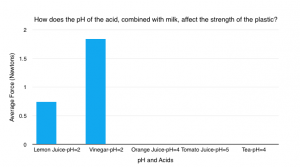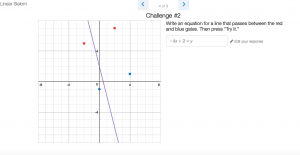The topic of my experiment is making milk plastic with milk and an acid. I started my research in early September to find which experiment I would want to do. After researching, I created my research question and began creating my experiment in late September. Through October, November, and December I wrote my procedure and conducted my experiment. I had to redo it a few times due to errors. After conducting the experiment, I wrote my conclusion and data analysis. The science fair itself was conducted on January 23rd. To improve my experiment, I would test more acids with a wider range of pHs.
Data Tables and Graphs

Orange Juice
| Trial |
Force Used(Newtons) |
Average |
| 1 |
0 |
0 |
| 2 |
0 |
|
| 3 |
0 |
|
| 4 |
0 |
|
| 5 |
0 |
|
| 6 |
0 |
|
Tomato Juice
| Trial |
Force Used(Newtons) |
Average |
| 1 |
0 |
0 |
| 2 |
0 |
|
| 3 |
0 |
|
| 4 |
0 |
|
| 5 |
0 |
|
| 6 |
0 |
|
Tea
| Trial |
Force Used(Newtons) |
Average |
| 1 |
0 |
0 |
| 2 |
0 |
|
| 3 |
0 |
|
| 4 |
0 |
|
| 5 |
0 |
|
| 6 |
0 |
|
Lemon Juice
| Trial |
Force Used(Newtons) |
Average |
| 1 |
1 |
.74 |
| 2 |
1 |
|
| 3 |
2 |
|
| 4 |
.2 |
|
| 5 |
.1 |
|
| 6 |
.1 |
|
Vinegar
| Trial |
Force Used(Newtons) |
Average |
| 1 |
2 |
1.84 |
| 2 |
3 |
|
| 3 |
4 |
|
| 4 |
0 |
|
| 5 |
0 |
|
| 6 |
2 |
|
Data Analysis
From my data, I saw that changing my independent variable(the pH of the acid) affects my dependant variable(the strength of the plastic), and whether a plastic will form. As you can see from my graph, a high pH, such as the pH of the tomato juice, will not create a plastic and are therefore shown as zero on the graph. This is also seen with the orange juice and the tea, which both had a pH of four. This leads me to believe that any acid with a pH of 4 or higher will most likely not create an acid. The only acids to create a plastic were the vinegar and the lemon juice, which both had a pH of two. Although they had the same pH, the vinegar created a much stronger plastic. On the third trial, vinegar had its maximum force of 4, compared to the lemon juice who only had a maximum force of 2. Looking at all the trials, you can see that the force used for the lemon juice was mostly under 1, compared to the vinegar who’s force used was mostly over 1. I can conclude from this data that a more acidic acid, will create a stronger plastic.
Although the data seems accurate, there were most likely errors that occurred during the process, which can be seen in the data for the vinegar. In trials 4 and 5, the vinegar broke at a force of zero, which seems inconsistent compared to the other trials. Many factors could play into this. I might have used too much force when I started pulling down initially, which could have resulted in inconsistencies in the data. Another reason for this might be an inconsistent thickness in the plastic. It is nearly impossible to get an even thickness throughout the plastic because of how hard it is to roll out. This could have left some spots thicker than others. It could also explain why there is such a big difference between the lemon juice and the vinegar. Although I tried to prevent them from being different thicknesses, it is possible that one might have been slightly thicker than the other, resulting in more force needed to break it. Other than that, I see no other errors that may have occurred.
Abstract
The topic of the experiment is casein plastic made with milk and acid, for the purpose of determining how its strength is affected by changing the pH of the acid. I used five different acids with pHs of two, four, or five and made five batches of plastic, each with a different acid. Three acids with pHs of four and five did not create an acid. I tested the rest of the plastics by placing them on a spring scale and pulling to find how much force was needed to break them. I found that a lower pH results in a stronger plastic, and I am confident that my data and conclusions are correct.
https://docs.google.com/document/d/1A6zCdzAnj3LRsLJf6-hg9NGdfKtblScdwiqxnOpYb2k/edit?usp=sharing

